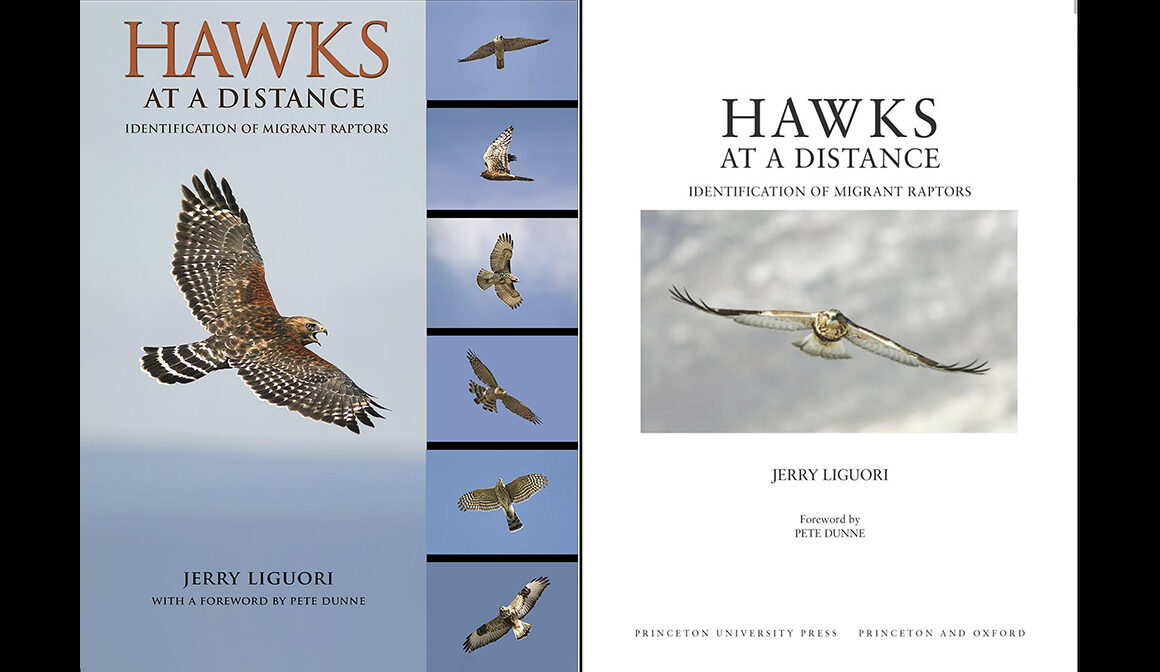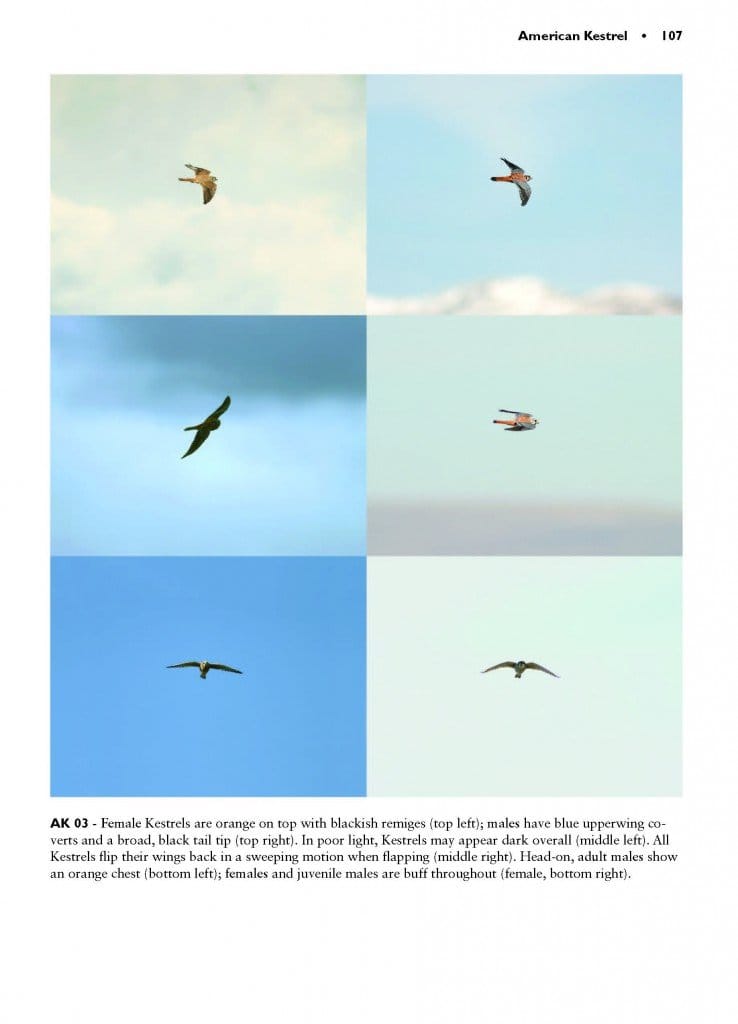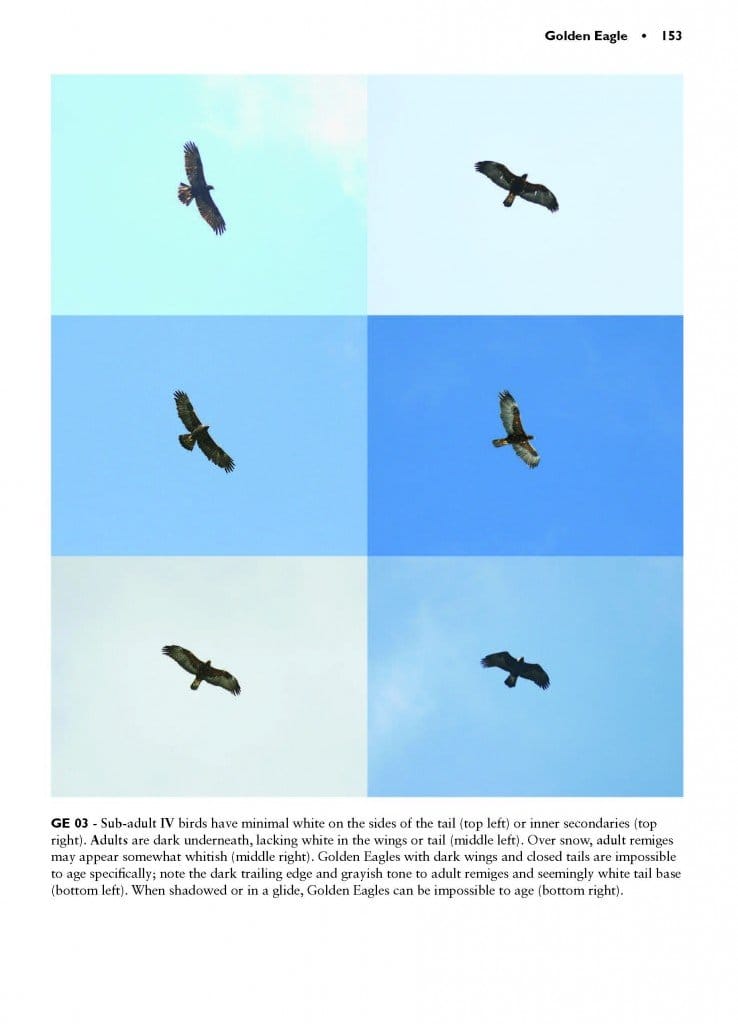
It’s hawk migration time again in North America, time to once again school ourselves in the art of identifying distant silhouettes and remembering the difference between a glide and a soar and a glide-wing flap-glide. My book of choice for this time of year is Jerry Liguori’s Hawks At A Distance: Identification of Migrant Raptors, a brilliant tutorial on how to recognize raptors by shape and flight style, distilling years of experience and expertise into 216 pages. Hawks At A Distance was one of the first books I reviewed for 10,000 Birds and I’ve decided to rerun it this month, partly to remind us all to read and use it, and partly because I’m preparing for a birding trip out of the country and I need all my brain power to make sure I pack the right camera lenses and hats. (Hey, I did review two books last month!)
Also, I’m thinking of Jerry Liguori himself, who died after a five and a half year struggle with ALS in December 2021. I never met Jerry, but I corresponded with him about his books and he commented on this review, saying, “Thank you, it was so nice to read and to see that you and others enjoy my books!….I love teaching and spending time with people eager to learn. And I am still learning. So, the interest expressed here in watching with me is a great compliment. Happy Hawk watching.” In addition to Hawks At A Distance, Jerry Liguori wrote a complementary guide, Hawks from Every Angle: How to Identify Raptors In Flight (PUP, 2005) and was a co-author (with Richard Crossley and Brian L. Sullivan) of The Crossley ID Guide Raptors (PUP, 2013).
Also, a note that in this review I mention that I had never read Hawks in Flight, by Pete Dunne, David Sibley, and Clay Sutton. This was remedied in 2012, when I reviewed the second edition. We are certainly rich in raptor identification and natural history books. And video resources. At a recent Queens County Bird Club meeting, hawk expert Josh Haas illustrated his presentation on migrating hawk identification with videos of hawk species on a split screen, so we could see the differences between, let’s say, a flying Red-tailed Hawk and a flying Broad-winged Hawk. The footage was from his new video guide Hawks on the Wing. I haven’t seen the whole video yet, but it looks promising.
The Review:
I confess, I don’t always love hawks. Sure, they’re beautiful and powerful, a reminder of the feral freedom of the skies. They’re also confoundingly difficult to identify, the eternal inscrutable spot in the distance. This is probably why I number so many hawk books in my collection.
There’s the slim Hawk Watch: At Guide for Beginners, bought on my first visit to the Cape May hawk watch, the classic A Field Guide to North American Hawks, part of the Peterson Field Guide series, the handy Hawks & Owls of the Great Lakes Region & Eastern North America, with its photographic comparison charts. (For some reason, I never bought the classic Hawks in Flight, by Pete Dunne, David Sibley, and Clay Sutton.) And, there are the non-field guide hawk books, the narratives that read like love songs to raptors and the huge coffee table books, gifts from non-birding friends.
So, looking a Jerry Liguori’s newest publication, Hawks At A Distance: Identification of Migrant Raptors (Princeton University Press, 2011), I ask myself, “Why? Why another hawk book?”
Liguori wrote Hawks At A Distance to fill a gap in raptor identification literature; he wanted to show birders how to identify distance hawks in flight, in migration, in the field, using photographs taken in “real life” settings. He is well qualified to write such a book. Liguori has conducted raptor migration counts at major U.S. hawkwatch sites, and has written articles on hawk identification for the American Birding Association and the Utah Birders blog. He is the THE go-to person for hawk identification. He is also the author of my current favorite hawk book, Hawks From Every Angle: How To Identify Raptors In Flight (PUP, 2005).
At the heart of Hawks At A Distance are 558 color photographs, most arranged as color plate composites comparing different versions of the same bird. Here is one of the three plates for American Kestrel.
There are photographs of buteos soaring overhead and harriers gliding low, of eagles coming at you head-on and flying away with only the tail in focus, of falcons backlit and kites in shadows. I was a little overwhelmed when I first opened the book, till I realized that each photograph has a purpose, illustrating the different forms or colors a raptor can take in the air. The number of plates per species varies, which makes a lot of sense. There are 2 plates for Turkey Vulture and 13 plates for Red-tailed Hawk.
Like The Crossley ID Guide, the photographs work best when used with the text. Liguori give a succinct “Overview” and “Plumage” description for each group (accipiter, buteo, etc.) and each species, delineating flight patterns, flight shapes, and all plumage variations (and if you thought you knew them all, you might be surprised.)
The most important identifying characteristics are in bold print, a feature I find enormously helpful. So, I learn that kestrels appear “dainty, slim overall, and lively and nimble in flight” but “can appear dark underneath on overcast days.” All the little clues that hawk watchers have accumulated over the years, all the details necessary to distinguish a kestrel from a Merlin, a Sharpie from a Cooper’s, are in the volume. Twenty-nine raptor species are covered (no owls): twenty common migrant hawks and nine additional “Uncommon Migrants and Others.”
The photographic plates and commentary take raptor identification to a level of extremely fine detail that may be unprecedented. In Golden Eagle plate 03 (left) we learn that “over snow, adult remiges may appear somewhat whitish (middle right)” and that “when shadowed or in a glide, Golden Eagles can be impossible to age (bottom left)”. This can be intimidating to birders like me, who are hawk identification challenged. But the beauty of Hawks At A Distance is that you can drill down through the different levels of text, taking in as much detail as you can handle at your level.
I recommend reading the “Introduction”, which defines terms like “remiges” (“secondaries and primaries”), and the last chapter, “Shapes”, in which multitudinous silhouettes (30-52) are presented for each of the 20 major species. I am a big silhouette fan. They help me focus on structure and not get distracted by plumage which, I now know, can differ depending on sex, age, light, weather, and angle.
All in all, this is an excellent, compact guide that nicely complements Hawks From Every Angle. Put the two books together and you get the raptor identification guide of every hawk watcher’s dreams. The only criticism I have is that I want more! I want more on Short-tailed Hawk, one of the uncommon migrants given briefer treatment. I want companion videos, showing the flight patterns in action. I want Jerry Liguori to come east and do a hawk watch with me.
Both books are published by Princeton University Press, which means the binding and paper are of high, sturdy quality, and that the color photographs are well printed. (Many of the full-page photographs are lovely in their own right, not only as teaching tools.) Both books are priced very reasonably in paperback format (see below).
I still don’t always love hawks. But I am quite fond of both Liguori guides, and dream of the time I can look at that speck in the sky and say, “Large accipiter, powerful flight, stiff wingbeats–Northern Goshawk!”
I’m curious about your experiences with these guides or other hawk books (or apps) in the field. Which guide worked best for you? Which book do you keep in your car during hawk migration season? And, in a perfect raptor world, which hawk guide author would you choose to spend an afternoon hawk watching with?
Hawks at a Distance: Identification of Migrant Raptors, by Jerry Liguori, with a foreword by Pete Dunne
Princeton University Press, 2011. 216 pp., 6 x 8.5 in.
ISBN-10 : 0691135592; ISBN-13 : 978-0691135595
Paper $19.95; Kindle $9.99















Leave a Comment